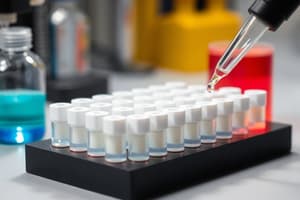Podcast
Questions and Answers
How does the polarity of a compound affect its movement on a TLC plate?
How does the polarity of a compound affect its movement on a TLC plate?
- More polar compounds move faster due to lower interaction with the stationary phase.
- Less polar compounds move slower because they interact more with the stationary phase.
- Less polar compounds are not affected by the stationary phase.
- More polar compounds move slower as they interact strongly with the stationary phase. (correct)
What is the purpose of marking the starting point on a TLC plate?
What is the purpose of marking the starting point on a TLC plate?
- To indicate where the solvent would be applied.
- To prevent the samples from moving off the plate.
- To ensure samples are applied evenly along the plate. (correct)
- To help in accurately measuring the solvent front.
What happens if the TLC plate touches the solvent in the chamber?
What happens if the TLC plate touches the solvent in the chamber?
- The results will not be affected and can be interpreted normally.
- The solvent will not move up the plate due to obstruction.
- The samples will dissolve completely, making results invalid. (correct)
- The stationary phase will absorb the solvent, altering the analysis.
Which step should be taken immediately after the optimal development time for a TLC plate?
Which step should be taken immediately after the optimal development time for a TLC plate?
Why is Ninhydrin used in the detection process of a TLC plate?
Why is Ninhydrin used in the detection process of a TLC plate?
What is the significance of the RF value in chromatography?
What is the significance of the RF value in chromatography?
What is a crucial step before applying the sample to the TLC plate?
What is a crucial step before applying the sample to the TLC plate?
What does closing the lid of the chamber during TLC prevent?
What does closing the lid of the chamber during TLC prevent?
What is the primary role of the stationary phase in chromatography?
What is the primary role of the stationary phase in chromatography?
What is the main principle that drives separation in Thin Layer Chromatography?
What is the main principle that drives separation in Thin Layer Chromatography?
Which of the following describes the ideal solvent system in Thin Layer Chromatography?
Which of the following describes the ideal solvent system in Thin Layer Chromatography?
What type of information does Thin Layer Chromatography primarily provide?
What type of information does Thin Layer Chromatography primarily provide?
In the context of TLC, what does moving faster in the mobile phase indicate about a compound?
In the context of TLC, what does moving faster in the mobile phase indicate about a compound?
What materials are commonly used to construct a TLC plate?
What materials are commonly used to construct a TLC plate?
Why is it necessary for the components of a mixture to interact differently with the stationary and mobile phases in chromatography?
Why is it necessary for the components of a mixture to interact differently with the stationary and mobile phases in chromatography?
What effect does the polarity of compounds have on their movement in Thin Layer Chromatography?
What effect does the polarity of compounds have on their movement in Thin Layer Chromatography?
Flashcards
Chromatography
Chromatography
An analytical method that separates closely related substances in a mixture.
Thin-layer chromatography (TLC)
Thin-layer chromatography (TLC)
A type of chromatography where a thin layer of silica gel is used as the stationary phase.
Stationary phase
Stationary phase
The substance that is immobile in chromatography, usually a solid or a gel.
Mobile phase
Mobile phase
Signup and view all the flashcards
Differential Partitioning
Differential Partitioning
Signup and view all the flashcards
TLC Plate
TLC Plate
Signup and view all the flashcards
Retention factor (Rf)
Retention factor (Rf)
Signup and view all the flashcards
Analytical technique
Analytical technique
Signup and view all the flashcards
Rf Value
Rf Value
Signup and view all the flashcards
TLC Development
TLC Development
Signup and view all the flashcards
Less Polar Compounds
Less Polar Compounds
Signup and view all the flashcards
More Polar Compounds
More Polar Compounds
Signup and view all the flashcards
Solvent Front
Solvent Front
Signup and view all the flashcards
Study Notes
Medical Biochemistry I - Lab Exercise 2: Introduction to Thin-Layer Chromatography
- Objectives:
- Introduce general chromatography principles
- Understand Thin Layer Chromatography (TLC)
- Separate and identify amino acids in a mixture using TLC
Chromatography
- Definition: An analytical technique used to separate closely related compounds in a mixture.
- Types: Paper, thin layer, column, size-exclusion, ion exchange, affinity, and high-performance liquid chromatography (HPLC).
- Separation Mechanism: Differences in equilibrium distribution between the stationary and mobile phases. This is due to the nature and interaction between the components and the two phases.
Principle of Chromatography
- Separation Principle: Different molecules in a mixture separate as they move through the stationary phase with the help of the mobile phase.
- Differential Movement: Some components stay longer in the stationary phase, moving slowly, while others move quickly through the mobile phase.
- Visualization: After separation, components are visually seen as spots at different heights on the plate. Analysis of their colour and position are used for identification.
Thin-Layer Chromatography (TLC)
- Technique: Used to separate and identify compounds of interest.
- Qualitative and Quantitative Data: Provides qualitative data; with sufficient care, can also determine quantitative data.
- TLC plate: A thin layer of silica adhered to a glass or aluminium support.
Stationary and Mobile Phase
- Stationary Phase: Silica gel within TLC.
- Mobile Phase: Solvent or solvent mixture.
- Compound Solubility: Ideal solvents allow components to have varying degrees of solubility.
- Partition Equilibrium: Separation arises from the partitioning equilibrium of components in the mixture.
Separation of Compounds
- Differential Partitioning: Compounds interact differently with the stationary and mobile phases based on polarity.
- Affinity for Stationary Phase: More polar compounds interact strongly with (polar) silica, moving slower
- Affinity for Mobile Phase: Less polar compounds interact less with silica and more with the solvent, allowing them to move further up the plate.
Experimental Procedure
- Spotting: Draw a horizontal line with a pencil at the bottom, top, and edge of the TLC plate (1cm). Draw spots at the line equally spaced apart. Each spot represents a sample..
- Sample Application: Apply a small spot of solution using a capillary tube (1 cm from bottom edge), Place samples in a row, each moving separately .
- Chamber Filling & Placement: Pour appropriate solvent into a chamber to a depth of less than 1cm; put the TLC plate in the chamber; lid on,.
- Solvent Movement: The solvent moves by capillary action up the TLC plate; meeting and carrying samples; avoid solvent touching the spots.
- Chamber Removal/Drying: Remove the plate from the chamber before solvent reaches the silica surface and dry.
- Solvent Front Marking: Mark the solvent front (highest point of solvent travel)
Ninhydrin Amino Acid Detection
- Detection: Remove and dry the TLC plate; use Ninhydrin reagent to spray; primary amino acids turn purple
Rf Calculation
- Definition: Rf value is the ratio of the distance a substance travels to the distance the solvent travels.
- Calculation: distance moved by sample / distance moved by solvent
Studying That Suits You
Use AI to generate personalized quizzes and flashcards to suit your learning preferences.



